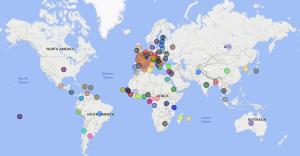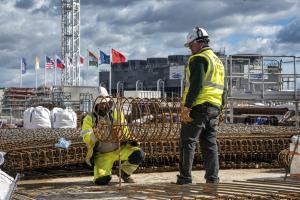A truly cosmopolitan community
Four times as large as the Vatican City State, but slightly smaller than the Principality of Monaco, the ITER international enclave covers 180 hectares, of which about half is occupied by buildings and infrastructure. The land was conceded by France to the ITER Organization in 2010, and will be returned once ITER has completed its scientific program. Whether working directly for the ITER Organization, for an ITER Domestic Agency, or for one of the approximately 700 institutions or contracting companies present on site at any given moment, almost 6,500 people hold an ITER "passport" in the form of an access badge to the ITER enclave.
Few places, if any, host a more cosmopolitan community on such a small stretch of land. The people working on ITER territory hail from 90 countries (up from 68 in 2020), from "A" like Afghanistan to "V" like Venezuela. Reflecting the important presence of French companies on site and the necessary interaction with the host country, the largest cohort is French (3,885). Italians come second (421), followed by Spaniards (335), Indians (254), Chinese (214), Portuguese (165) and Romanians (119). There are almost as many Americans (42) as there are Algerians (44) or Moroccans (46), all involved in one way or the other in the realization of ITER.
Twenty-eight countries—Bangladesh, Cyprus, Gambia, Madagascar and Mali among them—have only one representative on site, as does a little-known administrative entity called the "United States Minor Outlying Islands"¹ made up of a string of small islands and atolls in the Pacific and the Caribbean. Albania, Argentina, Jordan, Mauritius, Congo and Tanzania have two; Lebanon and Gabon have four (at the time of this writing). There are 7 Ukrainians, 3 Serbs, 1 Kosovar and 96 Russians working to build ITER.
Of close to 6,500 people, approximately 1,600 are directly attached to the ITER Organization either as staff (1,066), ITER Project Associates (216) or interim personnel (359). The largest contractors present on the ITER construction site are Assystem (152)—part of the ITER Organization's Construction Management-as-Agent MOMENTUM consortium and a variety of engineering support contracts—followed by the European Domestic Agency's Architect Engineer Engage (102) and the construction company GTM Sud (94). Of the 707 contracting companies or institutions represented on the construction site, 50 have more than 20 employees; their area of intervention includes construction (Valérian, Demathieu Bard, Ferrovial-Agroman), fabrication (CNIM, ASG Superconductors), logistics (DAHER), crane operations (FOSELEV, Ponticelli Frères, Vernazza Autogru), scaffolding management (Entrepose Échafaudages), services (Sodexo, Onet Services) and other support activities. The rest of the workforce is distributed among 158 companies that have between 5 and 20 employees and another 368 companies (half of the total) that have only one representative on site.
Since construction began in the summer of 2010, an estimated 15,000 people from 5,000 companies have been involved in the myriad activities that building ITER requires.
English is the lingua franca of the ITER enclave. As a mother tongue however, it is only spoken by a small proportion of its denizens: 15 percent within the ITER Organization, certainly much less for the construction workforce. But communication on the ITER site is not an issue: supervisors have sufficient command of the language to interact with ITER Organization or Domestic Agency responsible officers and they can pass on the information to their team. Many workers have a basic understanding of English and, when falling short, resort to smartphone apps that prove efficient in conveying simple messages.
The culture that the denizens of the ITER enclave have developed over the years transcends nationality and language. In all aspects—large and small—it reflects the nature and values of the unique international project they are committed to.
¹ Other islanders hail from French Polynesia (2), Cape Verde (1), the Canaries, which belong to Spain (1) and the Caribbean microstate of Saint Kitts and Nevis (1).



